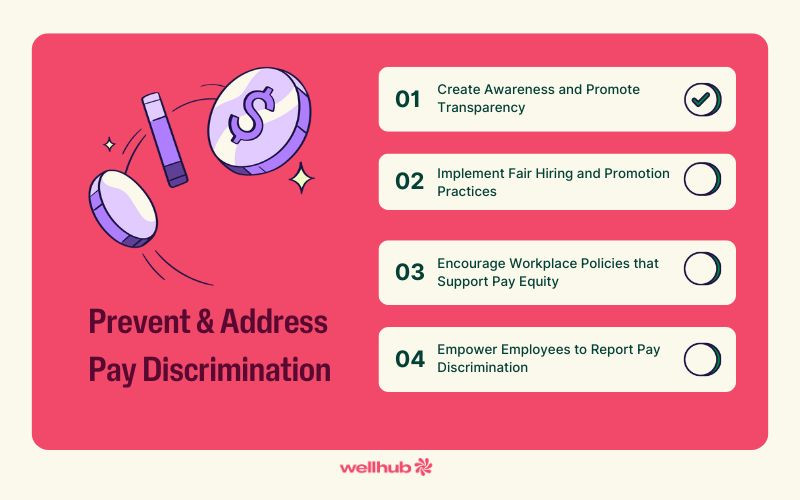Closing the Wage Gap: Navigating the Landscape of Pay Discrimination for Workplace Equality
Last Updated Jan 28, 2025

Pay discrimination isn’t just an ethical issue—it’s a challenge that can seriously undermine the success of your organization. When employees are paid differently for equal work due to factors like gender, race, or age, it breeds frustration and hinders both morale and productivity. Worse, it can lead to legal battles that damage your reputation.
Getting a firm grasp of how pay discrimination manifests is the first step in creating a fairer, more inclusive workplace. Let's break down the different types of pay discrimination, from gender-based pay gaps to age-related biases. This will empower you to identify inequities that take shape and the legal protections designed to combat them. You’ll walk away with actionable strategies to identify and prevent wage discrimination in your own organization—whether through pay audits, transparent hiring practices, or fair promotion policies.
Ready to make a difference? Let’s dive into how you can deliver pay equity to foster a company where everyone’s contributions are valued and rewarded.
Definition and Types of Pay Discrimination
Pay discrimination, also known as wage discrimination, occurs when an individual is unequally compensated based on factors unrelated to their job performance or qualifications. Common qualities that contribute to unfair pay include gender, race, age, ethnicity, or disability, which can lead to:
- Gender-based pay discrimination. This occurs when individuals of different genders are paid differently for performing comparable work, Women may find themselves receiving lower wages than their male counterparts, for example, despite having similar qualifications and job responsibilities.
- Racial pay discrimination. Racial discrimination can lead to a minority employee making less than their white counterpart, even though they have equivalent skills, resume, and job title. This actively hinders any efforts to foster an environment that promotes diversity and inclusion.
- Age-based pay discrimination. Ageism can manifest in pay discrepancies, usually affecting older workers. Experienced employees may receive lower wages compared to their younger counterparts, despite their knowledge and skills due to stereotypes about aging that deprives organizations of valuable expertise and diverse perspectives.
- Other forms of pay discrimination. Beyond the categories mentioned above, pay discrimination can take a variety of other forms, including biases related to disability, sexual orientation, or religion. Such unfair treatment keeps individuals from realizing their full potential and acts as an obstacle to the overall success of the organization.
This unjust treatment can manifest in any form of pay, including: base salaries, bonuses, commissions, overtime pay, benefits, in addition to other forms of compensation.
Wage Discrimination Examples
Pay discrimination can take many forms, some more obvious than others. Combating it is an essential part of ensuring that workplaces uphold principles of fairness, diversity, and inclusion. Consider the following wage discrimination examples to sharpen your ability to spot pay inequities when you encounter them.
Gender-Based Pay Discrimination
In a software development company, two employees — one male and one female — possess identical educational qualifications, years of experience, and exceptional performance records. However, during an annual salary review, the team lead notices that the male employee is receiving a higher salary than the female, despite their similar qualifications and contributions to the company. This is a clear example of gender-based pay discrimination, where gender alone influences the difference in compensation, rather than merit or job-related factors.
Age-Based Pay Discrimination
Two sales managers for a retail chain have equal responsibilities and performance levels within their roles. However, during a company-wide evaluation, it becomes evident that the employee who is in their late 30s earns a significantly higher salary than the one in their 50s. In this situation, the pay disparity is based solely on their ages, rather than qualifications or job performance.
These examples illustrate how pay discrimination can manifest in real-life situations, negatively impacting employees and perpetuating inequality within the workplace. Addressing and eliminating these biases can help you create fair and inclusive environments where everyone's contributions are valued — and rewarded appropriately.
Legal Protections Against Pay Discrimination
Legal safeguards against pay discrimination play a vital role in upholding fairness and equality at work. Understanding these legal protections is essential for HR professionals, who must ensure that their organization’s compensation practices comply with these laws. Regular pay audits and transparent communication can help safeguard against potential violations.
Federal laws like Title VII of the Civil Rights Act of 1964 and the Equal Pay Act aim to combat discrimination based on gender, race, age, and other protected characteristics. Many states, including New York, also have their own laws, such as the New York State Human Rights Law that offers additional protection and remedies against pay discrimination.
Protected Classes
Protected classes are groups of individuals who are shielded from employment discrimination by law. The most common protected classes are:
- Gender
- Race
- Age
- Religion
- National origin
- Disability
- Sexual orientation
- Gender identity.
Employees belonging to these classes have the right to be treated fairly and equally in all aspects of employment, including compensation. Wage discrimination based on any of these protected characteristics is unlawful and can lead to legal consequences for employers.
Enforcement Agencies
There are agencies at both federal and state levels that are responsible for encouraging adherence to anti-discrimination laws. The primary federal agency responsible for investigating and enforcing employment discrimination claims is the Equal Employment Opportunity Commission (EEOC). The EEOC investigates complaints of pay discrimination and works to resolve disputes through mediation or, if necessary, litigation.
Similarly, many states have their own human rights agencies or labor departments responsible for handling discrimination complaints within their jurisdictions. These enforcement agencies provide individuals with avenues to report discrimination. They will then investigate the claims and pursue appropriate remedies and penalties against employers engaging in pay discrimination practices.
Implications of Pay Discrimination
Pay discrimination has serious effects on both individuals and the broader community. Economically, it makes it harder for employees to meet their financial needs and achieve stability. This limits their ability to save and invest, which can trap communities in cycles of poverty and worsening economic inequality. Over time, unequal pay can significantly impact wealth and retirement savings, leading to financial difficulties in later years and increased reliance on social safety nets.
Beyond finances, pay discrimination harms employees' mental health. It creates feelings of frustration and helplessness due to a lack of recognition for their work. This can hurt both job performance and overall wellbeing. In the workplace, pay disparities damage morale and productivity. Employees lose trust in management and feel less loyal and committed, leading to lower productivity and a lack of diversity within the organization.
How to Address and Prevent Pay Discrimination
Addressing and preventing pay discrimination requires an approach that prioritizes both transparency and fairness. Following these steps can help you reach goals aimed at improving workplace diversity.

Create Awareness and Promote Transparency
- Pay equity audits and assessments: Conduct regular pay equity audits to identify and rectify any disparities in compensation. These assessments can help uncover hidden biases and ensure that employees are fairly compensated based on their skills and qualifications.
- Salary transparencyinitiatives: Emphasize openness around salary structures within the organization. Sharing information about pay scales and the factors influencing compensation can help mitigate pay discrimination and build trust among employees. For example, publishing pay ranges for each role can help everyone understand the salary for their position. You could also share the results of pay equity audits with the organization.
Implement Fair Hiring and Promotion Practices
- Unbiased recruitment and selection processes: Ensure that recruitment processes focus solely on job-related qualifications and skills. This could mean implementing blind recruitment strategies, where candidate information irrelevant to job performance is removed during the initial screening stages.
- Clear criteria for promotions and raises: Establish specific criteria for promotions and salary increases. Generally, these should be based on performance and experience, or other productivity factors. This minimizes subjectivity and ensures employees are rewarded based on their merits.
Encourage Workplace Policies that Support Pay Equity
- Salary negotiation training: Provide employees, particularly women and minorities, with negotiation training to help them gain the skills to negotiate fair compensation during hiring and promotion discussions.
- Family-friendly policies: Implement family-friendly policies, such as paid parental leave for all employees, to support work-life wellness. This can help alleviate potential pay disparities based on real or perceived caregiving responsibilities.
- Flexible work arrangements: Offer flexible work options to accommodate diverse needs and enable employees to balance their personal and professional responsibilities more effectively.
Empower Employees to Report Pay Discrimination
- Establishing clear reporting mechanisms: Set up accessible and confidential channels for employees to report instances of pay discrimination or concerns about compensation practices.
- Protection against retaliation: Safeguard employees who report pay discrimination from any form of retaliation. Make sure they can voice their concerns without fear of negative consequences.
Following these steps can help HR professionals build a more inclusive workplace for every employee.
Combat Pay Discrimination for Improved Employee Wellness
Pay discrimination is directly tied to employee wellness. When employees feel undervalued or unfairly compensated, it can take a toll on their mental and emotional wellbeing. This often leads to job dissatisfaction and decreased productivity.
As you promote pay equity and create an inclusive workplace, you can boost employee morale, and ultimately build a healthier workforce. Of course, equipping your organization with the right tools can make all the difference. Wellness programs are a great place to start, especially since 93% of employees believe their wellbeing is just as important as their salary.
Wellhub can provide you with the resources to ensure your employees enjoy the wellness benefits they deserve. Speak with a Wellbeing Specialist to ensure your organization is equipped to support holistic wellbeing!

Company healthcare costs drop by up to 35% with Wellhub*
See how we can help you reduce your healthcare spending.
[*] Based on proprietary research comparing healthcare costs of active Wellhub users to non-users.
You May Also Like:
- An HR Guide to Preventing Disparate Treatment In the Workplace
- Dealing with Microaggression In the Workplace
- Three Compensation Types That Attract and Retain Employees (With Examples).
References
- Equal Rights Advocates (n.d.). Know Your Rights At Work: Pay Discrimination. Retrieved July 31, 2023 from https://www.equalrights.org/issue/economic-workplace-equality/pay-discrimination/.
- Fenton, Matthew K. (2022, May 16). Pay Discrimination In The Workplace: Am I Protected? Wenzel Fenton Cabassa, P.A. Retrieved July 31, 2023 from https://www.wenzelfenton.com/blog/2022/05/16/pay-discrimination-in-the-workplace-am-i-protected/.
- Wellhub. (2023, October 18). The State of Work-Life Wellness 2024. Retrieved August 16, 2024 from https://wellhub.com/en-us/resources/research/work-life-wellness-report-2024/.
- Working Now and Then. (n.d.) What is Wage Discrimination? Retrieved July 31, 2023 from https://www.workingnowandthen.com/new-york-discrimination/new-york-compensation-pay-discrimination/.
Category
Share

The Wellhub Editorial Team empowers HR leaders to support worker wellbeing. Our original research, trend analyses, and helpful how-tos provide the tools they need to improve workforce wellness in today's fast-shifting professional landscape.
Subscribe
Our weekly newsletter is your source of education and inspiration to help you create a corporate wellness program that actually matters.
Subscribe
Our weekly newsletter is your source of education and inspiration to help you create a corporate wellness program that actually matters.
You May Also Like

How to Build an Inclusive Return to Office Policy | Wellhub
The trend of remote work is reversing, and quickly. How are employers creating an inclusive policy?

Diversity and Inclusion in the Workplace: Why It Matters | Wellhub
Diversity and inclusion in the workplace improves innovation, performance, and wellbeing. A guild to build a culture where everyone thrives.

Expert Guide to Eliminating Weight Discrimination at Work | Wellhub
Build an welcoming workplace with practical strategies and expert guidance on policies, training, and culture to prevent weight discrimination.